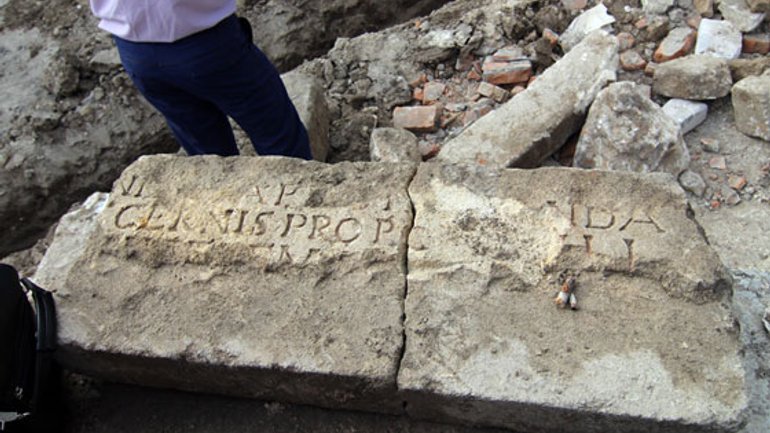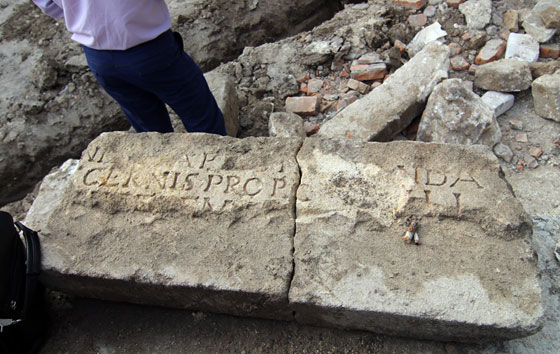Remains of ancient temple or Necropolis found on Podillia

A sensational discovery was made during the construction of a museum of regional studied in Horodok (Khmelnytsky region). Digging a trench, the builders found a curb tile, in which they found the inscription in Latin. As journalist-ethnographer Dmytro Polukhovych told RISU, experts assume that this is a block of a destroyed church or an old necropolis.

The site itself is scheduled to be completed by the Independence Day of Ukraine. At the moment, internal finishing works are underway and the adjacent area is being restored. Actually, it happened during the said works.“We were digging a trench for communications,” says the head of construction Yuri Hnatyi.
“It is laid exactly where there was once a sidewalk. So nobody was surprised when the bucket of the excavator hit the old curbs. The curbs are curbs – what is so strange about them? They were covered above with a layer of bricks of the sixties. This is also understandable – it was then that the apartment house was erected and the road was expanded simultaneously. The old sidewalks turned to be under the layer of construction rubbish and soil.
The found curbs interfered with the trench laying, they were pulled out. Four of them turned out to be ordinary, limestone-masonry. But the fifth immediately attracted the attention of the builders – it was decorated with a Latin inscription.
According to Oleg Fedorov, Head of the Department of the Culture of Nationalities, Religions and Tourism of the Horodok Regional State Administration, the discovery really turned out to be extremely interesting.
“The origin of the plate with the inscription did not raise questions from the beginning,” he said. “A hundred percent of it was a fragment from the destroyed in 1936 of the Church of St. Stanislaus, from which comes the icon of St. Anthony of Padua, famous for all of Podillya, or a fragment of the necropolis that was located near the temple and destroyed simultaneously.
It is worth noting that from an unfinished museum to a place where the church once stood, some 1,500 meters, and to the territory of the destroyed cemetery - in general, two dozen. In addition, in Gorodok it is no secret that for the construction of most public buildings erected before the Second World War (a huge house of culture, school, catering facilities, etc.), actively used stone and brick from the destroyed temples - the already mentioned church of St. Stanislaus (XVIII century), as well as the Church of St. Anne (XVII century) and the church of St. Alexander Nevsky (early twentieth century). They were all thrown into the air one night in 1936.
Church of St. Stanislaus, destroyed 1936
There was a rumor that for the construction of the above-mentioned buildings, the communists also used tombstones from the cemeteries near the churches of St Anne and St. Stanislaus. But to date, it has not been materially confirmed.
“We immediately photographed the find and sent the photo to the specialists,” says Oleg Fedorov. “Of course, the fragment of the inscription is not enough to talk about something definitely. But some conclusions can be made. Firstly, the inscription is Latin, not Polish. This allows the artifact to be attributed to the XVIII century, at least at the beginning of the XI century. The only words to read – “Cernis pro ...” - are translated from Latin, as “You can see” - a wording that is predominantly characteristic of epitaphs.
Specialists from the necropolis, however, noted that the block with the inscription was not a fragment of the usual tombstone. Given the shape and size, it most likely was a beam that covered the doorway to a crypt or a chapel-grave. Whoever was buried there is unknown at the moment, but it is clear that the person was not an ordinary man. However, one cannot rule out the fact that the beam has covered some of the doors or crypt in the destroyed church itself.
It is clear that the find will soon become an exhibit of a new museum. However, it has not yet been decided where it will be installed - in the exposition halls, or in front of the museum.
The find itself, as the builders believe, is symbolic and momentous. A strange coincidence - less than 2 months prior to the opening of the museum, one of the destroyed sacred monuments of Horodok reminded of itself in such a strange way.









